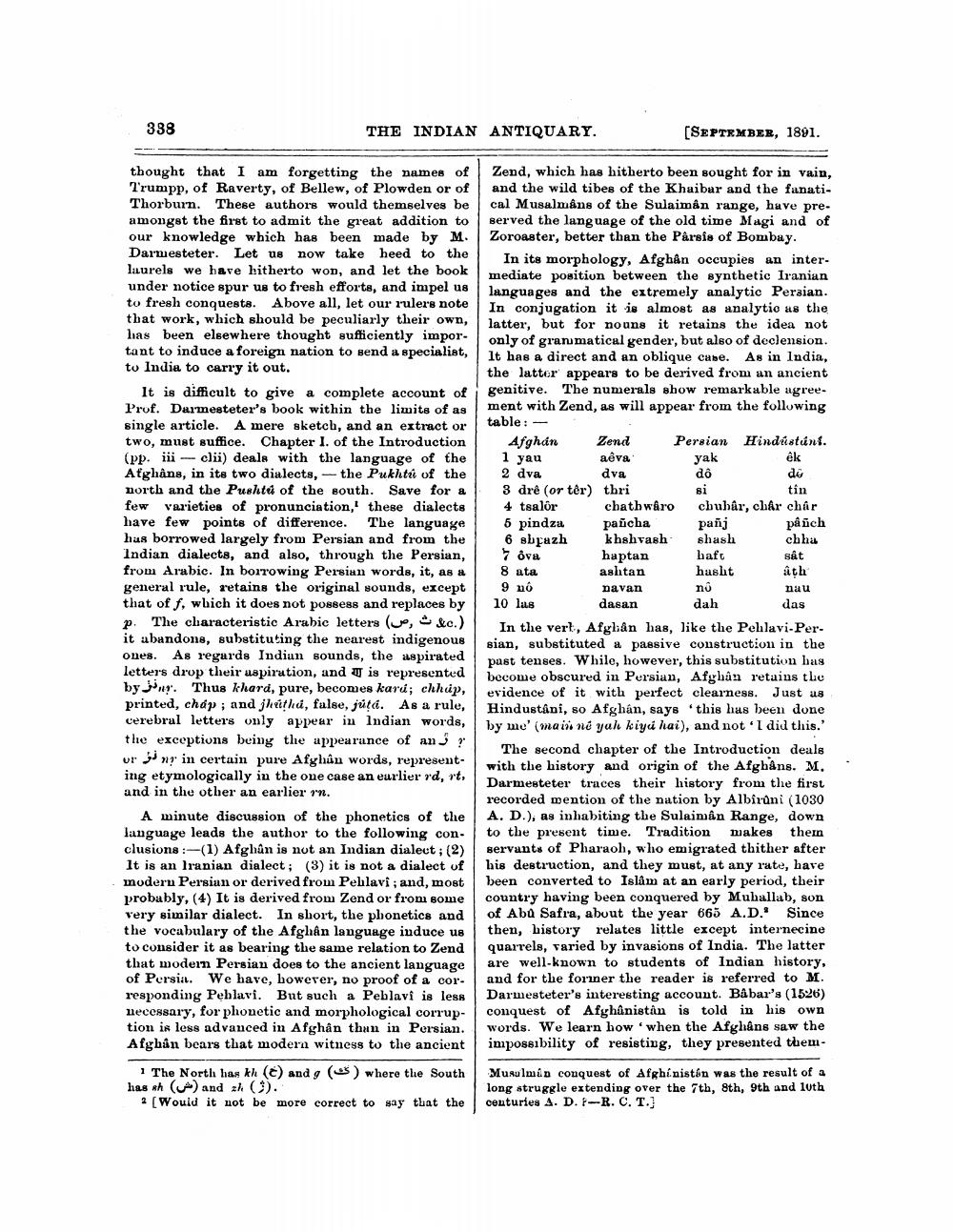________________
338
THE INDIAN ANTIQUARY.
[SEPTEMBER, 1891.
thought that I am forgetting the names of
Zend, which has hitherto been sought for in vain, Trumpy, of Raverty, of Bellew, of Plowden or of and the wild tibes of the Khaibar and the fanatiThorburn. These authors would themselves be cal Musalmans of the Sulaiman range, have preamongst the first to admit the great addition to served the language of the old time Magi and of our knowledge which has been made by M. Zoroaster, better than the Parsis of Bombay. Darmesteter. Let us now take heed to the
In its morphology, Afghan occupies an interlaurels we have hitherto won, and let the book
mediate position between the synthetic Iranian under notice spur us to fresh efforts, and impel us
languages and the extremely analytic Peraian. to fresh conquesta. Above all, let our rulere note
In conjugation it is almost as analytio as the that work, which should be peculiarly their own,
latter, but for nouns it retains the idea not las been elsewhere thought sufficiently impor.
only of gran matical gender, but also of declension. tant to induce a foreign nation to send a specialist,
It has a direct and an oblique cabe. As in India, to India to carry it out.
the latter appears to be derived from an ancient It is difficult to give a complete account of i
genitive. The numerals show remarkable agree. Prof. Darmesteter's book within the limits of as
ment with Zend, as will appear from the following single article. A mere sketch, and an extract or
table: - two, must suffice. Chapter I. of the Introduction Afghán Zend Persian Hindistúni. (pp. iii --- clii) deals with the language of the 1 yan
aêvayak
ek Afghans, in its two dialects, -the Pukhtu of the 2 dva
dva do
de north and the Pushtů of the south. Save for a 3 dré (or têr) thri
tîn few varieties of pronunciation, these dialects 4 tsalór chathwärochuhâr, chår char have few points of difference. The language 6 pindza pancha panj på nch hus borrowed largely from Persian and from the 6 sbgazh khshvash shash chha Indian dialects, and also, through the Persian, 7 ova
haptan haft
sát from Arabic. In borrowing Persian words, it, as a
8 ata
ashtan hasht ath general rule, retains the original sounds, except 9 no
navan nó
nau that off, which it does not possess and replaces by 10 las
dasan dah
das p. The characteristic Arabic letters (vo, &c.)
In the vert, Afglån has, like the Pehlavi-Perit abandons, substituting the nearest indigenous
sian, substituted a passive construction in the ones. As regards Indian sounds, the aspirated
past tenses. While, however, this substitution has letters drop their uspiration, and is represented
become obscured in Persian, Afyhân retains the by . Thus khard, pure, becomes kard; chhup,
evidence of it with perfect clearness. Just us printed, chap; and jhutha, false, jutá. As a rule,
Hindustani, so Afghán, says this has been done cerebral letters only appear in Indian words,
by me' (main ne yah kiyi hai), and not 'I did this.' the exceptions being the appearance of an !
The second chapter of the Introduction deals ur nr in certain pure Afghan words, represent
with the history and origin of the Afghans. M. ing etymologically in the one case an earlier rd, rt,
Darmesteter traces their history from the first and in the other an earlier ron.
recorded mention of the nation by Albiruni (1030 A minute discussion of the phonetics of the A.D.), as inhabiting the Sulaiman Range, down language leads the author to the following con. to the present time. Tradition makes them clusions :-(1) Afghûn is not an Indian dialect; (2) servants of Pharaoh, who emigrated thither after It is an Iranian dialect; (3) it is not a dialect of his destruction, and they must, at any rate, have moderu Persian or derived from Pehlavi; and, most been converted to Islâm at an early period, their probably, (4) It is derived from Zend or from some country having been conquered by Muhallab, son very similar dialect. In short, the phonetics and of Abu Safra, about the year 660 A.D.' Since the vocabulary of the Afghân language induce us then, history relates little except internecine to consider it as bearing the same relation to Zend quarrels, varied by invasions of India. The latter that modern Persian does to the ancient language
are well-known to students of Indian history, of Persia. We have, bowever, no proof of a cor. and for the former the reader is referred to M. responding Pehlavi. But such a Peblavi is less Darmesteter's interesting account. Babar's (1526) necessary, for phonetic and morphological corrup- conquest of Afghanistan is told in his own tion is less advanced in Afghân than in Persian. words. We learn how when the Afgháns saw the Afghan bears that modern witness to the ancient impossibility of resisting, they presented them
1 The North has kh (c) and g (3) where the South Musulmin conquest of Afghinistán was the result of a has rh ( ) and zh ).
long struggle extending over the 7th, 8th, 9th and 10th 2 (Would it not be more correct to say that the centuries 4. D.-R.C.T.




